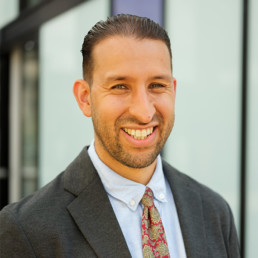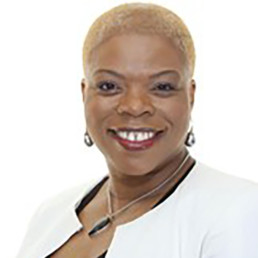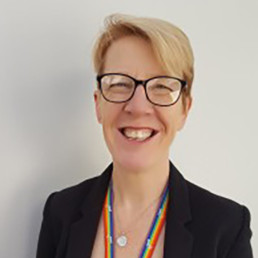To Belong Is Not Enough: Why We Must Move Towards Mattering

Written by Mohamed Abdallah
With almost two decades of experience, Mohamed started his journey in youth work and pupil referral units before spearheading groundbreaking inclusive practices and systems as a leader in an 'Outstanding' all-through mainstream school. Driven by a relentless commitment to positive change, Mohamed now dedicates his efforts to collaborating with school leaders across the nation as the Head of the Inclusive Leadership Course at The Difference.
“No one would care if I weren’t here.”
I can remember the words hitting me hard. As Designated Safeguarding Lead there were immediate red flags, but on a human level it broke my heart.
100% attendance, great progress, and never in trouble. On paper he belonged – but in reality he thought nobody cared.
Across the country, I hear the language of belonging increasingly referenced in discussions about student engagement, wellbeing, and success. And I welcome it. It’s a refreshing shift in our narrative about the student experience.
Still, something didn’t feel right. Then, it clicked.
It is not enough to simply belong; you should also matter.
My experience has shown me that a student can belong to a school community without ever feeling that their presence or contributions truly matter. A friend recently shared a US study with me that revealed a surprising finding: a sense of ‘belonging’ to a school community did not significantly affect academic performance. But instead there were other factors that determined success, such as participation and self regulated learning.
Think about it this way: You belong to a gym, but do the regulars know your name? You belong to a workplace, but do your ideas shape the way things are done? You belong to a school, but when you are absent, is there a noticeable void?
Mattering is more than belonging to a place or a community; it is about your significance.
One of the most prominent academic advocates for mattering is the US community psychologist Isaac Prilleltensky. He argues that developing a strong sense of mattering depends on two things: feeling you are valued, and feeling that you add value – whether that be within your workplace, your community, your family, or your friendship group. In the UK, my good friend Luke Billingham has been one of the most influential thinkers and writers on young people and mattering.
The Three Components of Mattering in Schools
After multiple voice notes back and forth, Luke and I sat down to discuss this matter (see what I did there!), and we asked:
If a student stopped coming to school tomorrow, would they feel like their absence was noticed?
Does every student have positive and affirming relationships with peers and at least one adult?
Are students actively shaping the school environment, or are they simply complying with expectations?
These questions helped us think more deeply about mattering. Of course, students should belong. But would we be satisfied as school leaders with 100% attendance, high attainment, and zero suspensions, yet students still told us, “No one would care if I weren’t here”?
They should feel they matter.
Reflecting on our experiences in different schools, Luke and I identified some key factors which we think enable students to develop mattering; Voice, Relationships, and Participation.
- Voice: Too often, schools claim to prioritise student voice while keeping real decision-making at the leadership level. But voice is not just about being heard. Schools must embed student experience and perspectives into decision-making, not just through surveys, but by creating opportunities for meaningful dialogue and change. Even when student perspectives challenge us, they offer uncomfortable truths we must engage with. When students see their input shape school culture, they matter.
- Relationships: A student might belong to a school, but do they have relationships that affirm their worth? Schools could cultivate opportunities for positive peer relationships to create strong social bonds, and to ensure every student has at least one trusted adult. Relationships built on trust and recognition, and environments where students feel valued and connected.
- Participation: Mattering isn’t just about feeling noticed, it’s about feeling needed. Students need opportunities to contribute meaningfully to their school communities. This goes beyond enrichment clubs; it means ensuring that students are actively shaping their environments. Whether through student-led campaigns, or engaging with the local community, authentic participation allows students to see their impact.
Why Mattering Matters for Inclusion
I worry that belonging is being used as a catch-all solution for inclusion, or dare I say it, a form of soft inclusion. For many students from marginalised backgrounds, belonging can feel conditional. They may be required to turn up, but do they feel like their presence and identity are essential? Do they see themselves reflected in the curriculum? Are their voices shaping school systems? Are their experiences acknowledged and valued?
Mattering addresses these questions by ensuring that students are not just included, but recognised as integral members of their schools. For students from underrepresented backgrounds, the feeling of mattering can be a protective factor against marginalisation and disengagement.
If we stop at belonging, we risk creating schools where students exist but don’t thrive, they comply but are disengaged, are included but unseen. The real challenge for schools isn’t just inclusion. It’s significance. Instead of asking, ‘Do our students belong?’ ask, ‘Do they know they matter?’
World Book Day 2025

Written by Robert Davies
Rob Davies is Associate Assistant Headteacher at Calderstones School in Liverpool. This role involves leading on anti-racism in education, sharing practical strategies, reflections, and initiatives to create a more inclusive, representative, and equitable school. He shares insights on decolonising the curriculum, diversifying reading materials, and fostering anti-racist practices in schools.
Another year, another World Book Day—same costumes, same characters. Harry and Hermione? Check. Little Red Riding Hood? Of course. The Gruffalo? Naturally. And let’s not forget Mrs. Trunchbull, stomping through the halls. Sound familiar? Thought so.
But here’s the thing—World Book Day can be so much more. It’s time to move beyond the usual suspects and reimagine it through a truly diverse lens. Let’s make it an event where every student sees themselves in the stories we celebrate.
Every year, World Book Day celebrates the magic of stories. But whose stories are we telling? Who do they inspire? When books and characters overwhelmingly reflect white, middle-class experiences, whose voices are missing? Are we selecting a diverse range of books that offer all children equitable opportunities to see themselves?
If not, isn’t it just Book Day?
At its core, World Book Day aims to “promote reading for pleasure, offering every child and young person the opportunity to have a book of their own.” But if we fail to approach it through an anti-racist lens, are we truly serving all students?
The Representation Gap in Children’s Books
In the UK, 33.5% of school-aged children come from ethnic minority backgrounds. Yet, between 2017 and 2019, only 7% of children’s books featured characters from these cultures—and just 5% had a Black, Asian, or Minority Ethnic main character.
Research shows that when children see themselves in books, it shapes their sense of identity and possibility.
Despite limited representation, excellent books exist that help students feel seen, foster belonging, and cultivate a love of reading. But do schools actively seek them out?
The issue goes beyond just introducing diverse books. What if teachers haven’t read them, or don’t understand their significance?
Whose culture has capital?
With a predominantly white teaching workforce (Runnymede Trust, 2020), how often is World Book Day shaped through an anti-racist lens? One of the biggest motivators for reading is emotion—how books make us feel (Dungworth et al., 2004). Naturally, educators promote books that resonated with them in childhood, shaped by their own experiences.
If most books being championed reflect the same narrow cultural perspectives, what message does that send? Who do these books inspire—and who gets left out?
Research further supports this. More children from ethnic minority backgrounds than white backgrounds say they don’t see themselves in what they read (40% vs. 30.5%), with Black students feeling this most acutely.
Making It a World Book Day
If World Book Day is to truly reflect all students, schools must take active steps to make it more inclusive. That’s exactly what we did at Calderstones School this year.
As one of Liverpool’s largest secondary comprehensive schools, diversity is our strength. But we recognised that World Book Day needed to reflect that diversity, ensuring all students felt represented and engaged.
So, we embraced the ‘world’ in World Book Day. We focused on books and authors from a variety of cultures and languages, fostering conversations about students’ mother tongues and cultural backgrounds.
We collaborated with Greenbank Primary School and Leeds Beckett University to involve primary school students and Global Ambassadors. Together, they read books from their home countries in their native languages—including Arabic, Basque, Farsi, French, Greek, Mandarin, Polish, Russian, Urdu, and more.
By showcasing this linguistic and cultural diversity, we highlighted the vital importance of representation in education. The readings were recorded, edited, and shared on the school’s social media. The response? Overwhelmingly positive. For many in our community, this was the first time their language and heritage were visibly celebrated in school.
How to Rethink World Book Day in Your School
If we are serious about delivering a truly inclusive World Book Day, here’s lets start with the following: 1. Move Beyond the Same Old Costumes
Rather than dressing up as characters from GCSE texts, consider why these books dominate the curriculum. Less than 1% of GCSE students study a book by a writer of colour—so why reproduce that marginalisation on World Book Day?
- Conduct a Student Voice
Ask students:
- What books would you love to explore?
- Do you see your culture and heritage reflected in the school library?
- What stories are missing from the shelves?
- Use these insights to shape book selections and discussions.
- Explore Translated Literature
Many beloved English books originated in other languages—Pinocchio was originally Italian. What other global stories could students discover? World Book Day can be an opportunity to highlight the rich traditions of storytelling from around the world.
Final Thought: A Call to Action
By embracing the ‘world’ in World Book Day, we made it more meaningful for our students. This is a step in the right direction—but it can’t stop here. Schools must challenge traditional reading lists, elevate diverse voices, and ensure that every child sees themselves in the stories they read.
We can’t diversify the teaching workforce overnight, but we can broaden our thinking. We must ensure that we view events like World Book Day through an anti-racist lens.
Because if World Book Day doesn’t include all stories, is it really World Book Day at all?
From Lettuce to Leadership: The Recipe for Real DEIB in Schools

Written by Sharon Warmington
Sharon is a diversity of race advocate and trainer, and CEO of the National Black Governors Network. She is an experienced academy trustee and school governor, corporate governance specialist. As an international Governance Practitioner and local school Governor, Sharon Warmington is also a public speaker, facilitator and a strategic leader, having worked nationally and internationally on projects in the private, public and third sector.
The room fell silent. A lone voice cut through the air like a scalpel.
“If we always do what we’ve always done, we’ll always get what we’ve always got.”
A murmur of agreement rippled across the table, but the truth hung heavy. Governance in education wasn’t evolving fast enough. The diversity deficit on school boards was glaring, and yet the solution was tantalisingly within reach.
Diversity, Equity, Inclusion, and Belonging (DEIB). A well-rehearsed mantra, a neatly arranged acronym, but in practice? Too often, it was all lettuce—bland, predictable, offering little more than a base layer. And just like a dull, uninspired salad, governance without true DEIB lacked texture, colour, and depth.
The First Ingredient: Diversity
Imagine stepping into a kitchen with only one ingredient. The outcome is predictable—uninspiring, repetitive, and ultimately ineffective. The same is true for governance.
Without representation across different racial, ethnic, gender, and socioeconomic groups, leadership decisions are made in an echo chamber. Diversity isn’t a ‘nice-to-have’; it’s the foundation upon which every other principle of DEIB is built. Without it, equity and inclusion remain unattainable.
The Dressing: Equity
Equity isn’t about throwing different ingredients into the mix and hoping for the best. It’s about recognising that some have been denied access to the kitchen entirely.
A governing board dominated by a single demographic can never truly understand the systemic barriers faced by underrepresented communities. Equity means creating real opportunities, ensuring those at the table have the tools, training, and access they need to contribute meaningfully.
It’s the dressing that brings balance—without it, even the freshest ingredients fail to shine.
The Crunch: Inclusion
Diversity and equity alone are not enough. Inclusion is the crunch, the bite, the assurance that every voice at the table is not just heard but valued.
A tokenistic approach—where individuals from diverse backgrounds are present but sidelined—rings hollow. Effective governance ensures all voices are not just present but shape the conversation. That means active listening, real participation, and a culture where speaking up is met with action, not silence.
The Secret Ingredient: Belonging
The final element, the one that brings it all together, is belonging.
A salad with great ingredients but no harmony is still a mess. The same applies to governance. If board members feel like outsiders—constantly having to prove their worth, explain their existence, or justify their perspectives—then DEIB has failed.
Belonging is the ultimate goal. It’s the point where leaders no longer ‘accommodate’ difference but celebrate it. It’s where representation is no longer an initiative but an expectation.
The Governance Gap: A Recipe for Change
The Department for Education (DfE) mandates that schools and trusts prioritise diversity in governance. The Public Sector Equality Duty requires active promotion of equality and inclusion. And yet, how many governing boards truly reflect the communities they serve?
The data tells its own story. Governing boards remain overwhelmingly white, predominantly male, and heavily weighted towards those over 50. Meanwhile, young voices, Black and Asian perspectives, and disabled representation remain painfully absent.
The solution? A new approach.
Turning Theory into Action
If schools are serious about DEIB, they must move beyond rhetoric. This means:
- Mapping the gaps: Who is missing from your governing board?
- Expanding the search: Looking beyond the usual networks—engaging with Black professional groups, student unions, disability organisations.
- Creating real pathways: Making governance accessible for those who may never have considered it.
DEIB isn’t about optics—it’s about outcomes. Schools with diverse governance bodies are better equipped to navigate the complexities of modern education. They make stronger decisions, build more inclusive policies, and ultimately create better environments for students.
The Call to Action
So, the question isn’t whether DEIB is important—it’s whether we’re brave enough to do the work.
Are we prepared to step beyond our comfort zones? To challenge long-standing norms? To build governing boards that truly represent the schools they serve?
The choice is ours. We can keep serving up plain lettuce, or we can create something extraordinary.
I Am Not Afraid

Written by Rachida Dahman
Rachida Dahman is an international educator, a language and literature teacher, and an educational innovator. She started her career in Germany as a teacher trainer advocating the importance of relationships above academics. She then moved to Luxembourg where she teaches German language and literature classes to middle and high school students. She is an award-winning poet, co-author of the best-selling book, ATLAS DER ENTSCHEIDER Entscheiden wie die Profis- Dynamik, Komplexität und Stress meistern.
School hallways are noisy. So much simmers in those corridors during breaks, and even more seems to ferment in teachers’ lounges, in the spaces of our schools as a whole. One might call it a festival of unresolved relationships, one that struggles to keep pace with the relentless pressure of coexistence, confrontation, and interdependence. By the end of a school day, we often stand slightly hunched, worn out, with restless legs that refuse to find stillness.
Amid this disorder, schools often become arenas of fear, environments where anxieties are not merely tolerated but systematically nurtured. These fears dance unseen and unchecked while the guardians of order, the teachers and educational institutions stand by as mere spectators. But what if this breeding ground of fear is not simply the result of carelessness or overwhelm, but rather the consequence of constant monitoring, control, and evaluation?
In my own school days, things were not so different. Students were expected to know little, challenge nothing, provoke no one, and certainly not disrupt. Teachers, on the other hand, constantly provoked, carried their small scandals into the school and sometimes even into the classroom. They unsettled us, and when we went home after school, we had little to report. Math, German, English, sports—subjects isolated from one another. Even the teachers lacked unity; how could the subjects possibly converse?
I remember a history teacher who filled gaps in knowledge with half-truths about controversial topics, as though he were a chronicler from another era. His stories brought the past to life, yet within the fog of his legends, the facts remained hidden. In math class, so-called wisdom from “great thinkers” was often reduced to hollow phrases—”Einstein probably said something like this.” These words sounded clever but were no more than glittering packages. In physics, correlation was sold as causation, “The moon and bad weather? That can’t be a coincidence!” Stereotypes were used so liberally that distinguishing between reality and fiction became a challenge.
In sports, fear was a constant companion. Our physical education teacher constructed scenarios of dread, “No training? That could lead to serious long-term damage!” The art teacher presented false dichotomies: “Either you draw like Van Gogh, or not at all.” Where were the nuances? Where was the space for creativity and individual thought? The music teacher, meanwhile, sought constant excuses to shield herself from constructive criticism: “It sounded fine, didn’t it? The acoustics were just bad.” The pursuit of excellence seemed replaced by a need for approval.
Parents observed this strange game, unfolding beyond grades and lesson plans, a struggle for “the best” for their children, though it was unclear what that even meant anymore. The best opportunities, the greatest potential, the most tailored support, concepts they discussed without ever fully grasping, haunted by the question of how much of their desires were genuine and how much were projections of societal expectations.
Children sensed what adults dared not articulate — that this was as much about demands as it was about support. What simmered here weighed on all of us, a pervasive burden whose origins no one could pinpoint but whose presence was undeniable.
This was a time when sports and music icons of the 1990s sparked cultural revolutions. With their bold hairstyles and extraordinary performances, they left powerful impressions that extended far beyond their fields. They influenced not only fashion and trends but also the values and norms of an entire generation, embodying success, individuality, and determination. Yet the school corridors simmered. A cacophony of invisible tensions echoed between the walls, while the daily routines left unspoken feelings like a tangled web between teachers, students, and parents.
Parents understand that children learn as much about social dynamics in school as they do about academic content. The lessons taught in classrooms are only a fraction of the school’s essence. It is the interpersonal relationships and encounters that leave lasting imprints, shaping self-worth. Sadly, this invisible yet essential layer often remains untouched and unformed. Students seem to be molded into compliant chess pieces in the game of knowledge dissemination. But what of their independence, their ability to express themselves, their courage to be authentic?
“Tell me how you speak to my child, and I will tell you who you are to them.” Language shapes our self-perception, and this is especially true in schools. The way a teacher speaks to students often reflects how they perceive their relationship with them. Are the words mere rhetorical phrases repeated out of habit, or is there genuine dialogue? Students are perceptive, quickly recognizing whether a teacher’s words make them feel valued or dismissed.
When communication is honest and direct, it creates a space where students can trust that their thoughts and feelings are welcome in school. Sadly, this is not always the case. Too often, we encounter linguistic “theater tricks,” half-truths, exaggerated dramatizations, or the subtle construction of false dichotomies, “Either you understand it, or you just don’t have what it takes.” Language, however, could serve a different purpose, reducing fear and building authentic connections.
The days of teachers as untouchable authorities, almost divine in stature, are over. This venerable role, where educators not only imparted knowledge but also moral judgments and ethical frameworks, has been increasingly supplanted by social media. Today, it is platforms and influencers, not teachers, that shape the values and norms of our students. Algorithms and digital streams dictate what is right and wrong, eroding the teacher’s role as a moral compass.
When I ask educators, “What do you think was truly happening then, and is it definitively different today?” I rarely receive a clear answer. Perhaps the point is no longer the answers but the questions themselves. Asking the right questions is a form of resistance in this era. Questions that inspire rather than inflame, that touch rather than coerce.
The fear of new technologies like artificial intelligence (AI) may be significant, but the greater threat lies in the erosion of human connections that should form the bedrock of education. True education requires profoundly personal and meaningful relationships, not just to address technological challenges but to renew and solidify the interpersonal foundations of teaching and learning.
Children are acutely sensitive to language. They are deeply aware of repetition, which is why rituals carry emotional weight. As adults, especially in classrooms, how we speak to them matters immensely. Every word, every gesture reflects what we hope for them and believe in them. Relationships cannot thrive in utter chaos; they falter when they cannot take root in fertile ground. We must create spaces where these relationships can flourish, enabling genuine connections and fostering a positive learning environment. It takes courage to step into these spaces of vulnerability and to cultivate an atmosphere where students not only learn but also experience what it means to be part of a community. Every child has the right to sovereignty over their feelings and their story, and these spaces should be defined by openness and respect.
The future of education lies in empowering these voices, breaking rigid structures, and rethinking what is possible. As educators, we must rise to the challenge of creating spaces of vulnerability where students can safely express their fears and hopes, fostering an environment where learning is not only possible but joyful. By engaging in true dialogue, we can transform the corridors of our schools from places of fear into spaces of growth and understanding.
Only then can schools become what they were meant to be, vibrant places of learning where every person, regardless of their background or history, has the opportunity to thrive and find their voice. In honoring children as autonomous beings with their own stories and inalienable emotions, we unlock the fundamental relationships that make learning meaningful and transform schools into places of deeper humanity.
Al-Anon and Alateen - for relatives and friends of alcoholics

Written by Sonia Elmer-Soman
Sonia Elmer-Soman has a background in both law and education. She is a qualified law lecturer and has many years’ experience working as a legal practitioner in two prestigious law firms in the City and now within a reputable law firm local to her home town in Essex. She is also a qualified primary school teacher and is a guest writer for professional journals.
Most of us have heard of Alcoholics Anonymous (AA), but less well known about is Al-Anon and Alateen.
I met with Cheryl, a long-term member of Al-Anon, and she explains what Al-Anon and Alateen do, how they work and what impact they may have on the lives of members who are suffering from another’s problem drinking.
Q: What is the difference between AA, Al-Anon and Alateen?
A: Alcoholics Anonymous (AA) is a fellowship who come together from all walks of life and who share one common goal – to recover from alcoholism and achieve continued and sustained sobriety. Less well known about is Al-Anon (18+ adults) and Alateen (12-17 yr olds). Like AA, Al-Anon and Alateen are groups of men and women, of all faiths and walks of life, however this time with a focus on the person(s) affected by another’s alcoholism.
Q: Are there any entry requirements to joining Al-Anon and Alateen?
A: The only requirement is that you are suffering from the effects of another’s alcoholism.
Q: Are Al-Anon and Alateen a religious organisation?
A: No. Though “God” is referred to, it is a spiritual God, a higher power and everyone is free to define their own “higher power”. For some that may be a bird, a rose or the moon. For others it may be the group, prayer or meditation. For some the higher power may change over time.
Q: What does it cost to join?
A: Nothing. There are no fees associated with joining Al-Anon or Alateen. This is a non-profit organisation. Members are invited to make a donation towards room hire and/or literature at the end of the meeting. There is no requirement to contribute.
Q: Do the groups offer advice and/or counselling?
A: No. We are not trained therapists. “Let it begin with you” is an Al-Anon slogan which is the primary focus of the program. It suggests we shift the focus of our attention from the alcoholic in our lives to ourselves and begin living our own lives rather than interfering with theirs. The program offers a welcoming, friendly and confidential environment where group members understand in ways others cannot the difficulties we have experienced. We are free to speak of whatever is on our minds and we may share our experiences. Whilst the newcomer may need to offload a challenge or problem, most people find the focus naturally shifts away from the alcoholic and they start to gain insight into their own behaviour and how we may have contributed to our situation and how things may improve. We refrain from giving advice. There are many tools within the Al-Anon readings. Together we can find coping strategies to aid recovery of ourselves and to help us concentrate on our own wellbeing, behaviour, actions and reactions. Together we understand that we are powerless over alcoholism, that our lives have become unmanageable and we seek ways to assist our daily lives. We cannot control what the alcoholic does or does not do and we should not seek to change or control that which we cannot. Instead, we focus on the control we have over ourselves. We acknowledge that alcoholism is a disease and we develop understanding that, through our actions, we aid recovery of ourselves and, potentially, the alcoholic if we seek to change our own actions and feelings about the situation rather than focussing solely on the actions and feelings of the alcoholic.
Q: What do meetings typically involve?
A: A warm, friendly, non-judgemental welcome from a group of individuals who are going through or have gone through the same/or similar challenging journey as you. A cup of tea and a box of tissues are at the ready if needed. Each week a different topic is covered. This could be anything from ‘Resilience’ to ‘Hyper-vigilance’ to ‘Boundaries’ to name just three, but there are many more. We may do an inspirational reading for that topic and then offer up the table to anyone who would like to contribute either with a reading or with their thoughts or own personal experience which may or may not be related to the chosen topic. There may be shared experiences , but each member will have their own unique perspective. By keeping an open mind, you may hear something you can identify with, which may assist you to move forward. Newcomers often feel they have nothing helpful to share but often they provide golden nuggets that are incredibly beneficial to long-time members.
Q: Will the meetings help me and/or my family and the alcoholic?
A: We receive so much positive feedback. Al-Anon is about changing the actions and behaviours of ourselves rather than focussing on the alcoholic (as we have no control over the latter). Let it begin with us. These meetings might show us that ways in which we thought we were helping may have, in fact, negatively impacted potential recovery of ourselves and the alcoholic. In the absence of judgment, blame, guilt and shame, individuals feel free to openly discuss matters and often say they feel like a weight has been lifted when they leave the sessions.
Q: What is the minimum amount of sessions I should participate in?
A: It is completely up to the individual. We say it is best to go for at least six sessions, to learn how Al-Anon works and decide whether the program is for you. Sometimes it may not be the right time, but often people come back. There is no minimum or maximum term. Some individuals come for a few weeks, some dip in and dip out when convenient for themselves. Others have been attending for many years.
Q: Will what I say be treated in confidence?
A: Yes, anonymity is the foundation of Al-Anon. In order for everyone to feel safe, it is part of the ethos and ethics of the group that everything spoken about within the group stays in the group.
Q: What may be the benefits of joining Al-Anon and Alateen?
A: There is something hugely comforting in knowing that there are others, many others, out there who share the same challenging problems as you. Alcoholism is a family disease which affects the whole family. Young people attending Alateen meetings or adults attending Al-Anon in person or online, can see that they are not alone and that they did not cause the problem, neither are they responsible for their relative’s or friend’s drinking. Young people can benefit from sharing experiences with others of their own age and this often helps them understand their alcoholic relatives and recognise they are not to blame for the difficulties experienced with their home/families and could, in time, lessen the effects of having lived with alcoholism.
Q: Which one word would you use to describe Al-Anon and Alateen?
A: Insightful.
▪▪▪▪▪▪▪▪
Poor mental health and resulting drug or alcohol addiction spans generations and boundaries of socio-economic and cultural backgrounds. It is not a life-style choice. It is a disease which affects the whole family, relatives and friends.
For too many families in the UK, there remains a stigma associated with mental health and addiction issues. Guilt, shame, embarrassment and denial prevent sufferers and their families from seeking early intervention. All too often, without support, sufferers and their loved ones hide in plain sight and battle illness behind closed doors which leads to isolation, depression, anxiety and desperation.
Speaking with Cheryl and seeing first-hand the wonderful support offered to families and friends of alcoholics is heart-warming and fundamentally essential to the wellbeing of those affected.
Wherever possible, it is crucial that institutions such as the NHS, Education, Social Services, Addiction Services and the Criminal Justice System signpost this free service, so that families and friends of alcoholics can, if they so choose, access this vital service. The hope is that their voices are heard and their lived daily reality is understood. No longer should families and friends be isolated behind closed doors and remain the silent witnesses to addiction.
What one word would I use to sum up these groups? Empowerment.
Diversifying English Literature texts: Five ways to get your schools to invest

Written by Jessica Tacon
Jessica Tacon is second in charge of the English Department at City of London Academy Highgate Hill and is a member of NATE’s (National Association for the Teaching of English) ‘Reviewing Literature’ working group. She created The Right Writing campaign which aims to improve racial diversity in English Education.
The title of this piece reflects an ongoing challenge in education, but also an opportunity. While many schools and educators have made strides in diversifying their English curricula, there’s always room for progress. Students across the country deserve to see themselves reflected in the texts they study, while also being exposed to a wide range of perspectives. Diverse literature enriches learning experiences, fosters empathy, and ensures every student feels valued.
Here’s a brief overview of why a diverse and inclusive curriculum is essential:
- Representation matters: Research by Penguin Random House revealed that many students never study a text by a writer of colour, apart from a few poems in their GCSE studies. They also found that only 7% of students study a text by a woman, and just 0.1% study a text by a woman of colour. Every child deserves to see their experiences and identities reflected in what they read. Not only does this enhance engagement and enjoyment, but it can also lead to better academic outcomes.
- Retention in English Studies: When students don’t see themselves or diverse perspectives in their English lessons, they may perceive the subject as irrelevant. This may lead to a drop in the number of students pursuing English at A-level, which in turn impacts representation in higher education and English-related fields. A diverse curriculum can break this cycle by making the subject more relatable and meaningful.
- Broadening horizons: While representation is crucial, it’s equally important to introduce students to experiences, cultures, and voices beyond their own. Literature has always been a bridge to other worlds, offering insights into lives that differ from our own. This is a fundamental aspect of fostering curiosity and empathy in young people.
- Addressing historical imbalances: Historically, the English curriculum has often overlooked diverse voices. As educators, we have the opportunity (and responsibility) to address these imbalances and create and embed a curriculum that is inclusive, honest, and representative of a wide range of experiences.
Despite these clear benefits, the teaching of a diverse and inclusive range of literature texts isn’t yet the norm in all schools.
Support (and essential investment) is needed from senior leads in schools, and multi-academy trusts, to make this a reality. It is challenging as individuals may not be English specialists, but the points above highlight how a change in English can have a far-reaching impact on young people.
With this in mind, I would like to explore the common barriers to change and five solution-focused strategies to help schools embrace a more inclusive curriculum.
Strategies
Strategy 1: Emphasise the positive impact on students
Barrier: Leadership may focus on the potential challenges rather than the benefits of inclusivity.
Solution: Highlight the research-backed benefits of a diverse curriculum. For instance, the research by Penguin Random House shows students are more engaged when they see themselves reflected in their studies, and they perform better academically. Explain how inclusive texts also broaden students’ horizons, fostering empathy and critical thinking by exposing them to new perspectives and cultures. Frame change as being much less of a risk than continuing to teach a set of texts which actually may be disengaging students in the English classroom.
Message for leadership: A diverse curriculum creates a more engaged and motivated student body, which translates to higher achievement and a stronger school culture.
Strategy 2: Frame diversity as a shared responsibility
Barrier: Leaders may feel diversity initiatives are an additional challenge in an already complex system.
Solution: Present inclusivity as a professional and moral responsibility to address historical imbalances in education. Position the school as a leader in creating a curriculum that prepares students for life in a diverse and interconnected world.
Message for leadership: Diversity isn’t just a ‘nice-to-have’; it’s essential for fostering a fair and well-rounded education. Implementing an inclusive curriculum aligns with the school’s duty to provide all students with an equitable experience.
Strategy 3: Offer practical solutions to time and workload challenges
Barrier: Leaders may worry that introducing new texts will increase workload for already overstretched staff.
Solution: Reassure them that high-quality, ready-to-use resources are available. Platforms like BBC Bitesize offer support materials on a range of texts including some recently added to diversify exam board text options, such as My Name is Leon and Leave Taking. BBC Bitesize, as its name suggests, is a great jump-off point for exploring a diverse range of texts by breaking them down into manageable chunks.
Message for leadership: Implementing an inclusive curriculum doesn’t need to add extra strain. Leverage existing resources and expert support to streamline the process.
Strategy 4: Address staff confidence with professional development
Barrier: Some educators may feel unprepared to teach unfamiliar texts or discuss sensitive topics.
Solution: Advocate for investment in professional development such as training sessions or workshops that help staff gain confidence in teaching diverse texts. Highlight that introducing new material can be professionally invigorating, offering opportunities for growth and fresh perspectives. For instance, one text added to AQA’s English Literature GCSE as part of their diversity drive is Princess and the Hustler by Chinonyerem Odimba. It’s a modern, engaging text that explores rich themes, literary techniques, and historical context, making it a rewarding teaching (and learning) experience.
Message for leadership: Building staff confidence through professional development ensures successful implementation while reinvigorating teaching practices.
Strategy 5: Present change as achievable and incremental
Barrier: Leaders may see curriculum reform as an overwhelming, all-or-nothing process.
Solution: If this is the case, advocate for a phased approach, starting with small but meaningful changes (such as introducing one or two new texts). You could suggest piloting new texts with specific classes before scaling up.
Message for leadership: Curriculum change doesn’t need to happen all at once. An incremental approach makes the process manageable while demonstrating the positive impact of inclusive texts.
Looking ahead
It’s important to acknowledge that change in education is rarely quick or easy. However, the potential benefits far outweigh the challenges. A truly diverse and inclusive curriculum not only enriches students’ academic experiences but also prepares them to navigate an increasingly interconnected world.
Of course, diversifying texts is just one part of creating an inclusive school environment. Staff training, teaching approaches, and the broader school culture all play critical roles in ensuring that diversity is embedded meaningfully and authentically.
Every student deserves an education that values their identity and broadens their horizons. As we move forward, let’s commit to making this vision a reality.
To access the BBC Bitesize GCSE English Literature collection, please visit: https://rebrand.ly/7d51da
Ramadhan in Schools: building welcoming and inclusive spaces

Written by Maslaha
Maslaha works to change and challenge the conditions that create inequalities for Muslim and Black and brown communities in education, criminal justice, health and on the basis of gender, in a continued climate of Islamophobia, racism and negative media coverage.
For many Muslims, Ramadhan is a time of joy, community and to recharge spiritually. Yet whether it’s choosing to pray at lunchtime or wear a hijab during these days, visible expressions of faith are often met with hostility – expressions of ‘Muslimness’ are treated as a threat. In this way, Ramadhan exposes the Islamophobia that persists throughout the rest of the year.
As educators, we know that when young people feel safe bringing their whole selves to a space, it directly impacts their self-esteem, confidence and sense of belonging. This psychological safety affects not only wellbeing, it directly influences students’ engagement, attainment, and overall success in school.
Young people and families have shared how Islamophobia in schools and policies like The Prevent Duty have left them feeling isolated and led them to self-censor out of fear of judgement or even punishment.
We asked young people and their families what they would like their teachers to know, or do during Ramadhan. We put together what they said into this resource, and share five practical ways to create safe and inclusive spaces for students who choose to observe it: Ramadhan in schools
For more resources to support you build your anti-racist classroom, deliver a culturally-relevant curriculum and nurture safe spaces for all young people, see Education | Maslaha
What's Special About You? Teaching Children About Identity.

Written by Mel Lane
Mel Lane (she/her) is Head of Education at Pop’n’Olly. She has been a primary school teacher and teacher trainer for nearly 30 years and worked in schools on LGBT+ inclusion policies with thousands of children and school staff. Mel is a co- author of What Does LGBT+ Mean? (Pop’n’Olly, 2021).
“I don’t know what’s special about me… I don’t have anything special about me,” a 5-year-old once told me. I’ll be honest, I was shocked. How could a child not be able to say a single thing that made them feel proud of themselves? – Nothing that singled them out from everyone else.
It was a learning curve for me. I realised that knowing what makes you special isn’t something that children necessarily know about themselves. For whatever reason, some children really need help with identifying what makes them stand out, what particular skills, talents and unique attributes help to define them.
Since then, I’ve really worked hard to ensure that I give children the language they need to talk about themselves – language that they can take with them throughout life to help them feel good about themselves, and to raise their self-esteem.
Here are some things you can do with your class:
- Help children understand that they are made up of a complex mix of things, including how they look, their skills and talents, and their personality. Some of these change and some stay the same.
- Pick a few different children each day. Talk to them in spare moments and find out what they like/dislike and are good at. Give them the language to praise themselves…
“Wow Molly, not everyone can remember to feed their dog every day/draw Pokemon so well/give someone space in the line without asking. That’s part of what makes you unique and special. Don’t forget to tell yourself that and feel proud.”
- Actively teach children how to praise each other and how to accept compliments…
“I noticed that Tariq kept going when the maths was tough today/ was really careful when cutting out the pictures/ balanced that ball in PE really well. Who’d like to compliment Tariq? Did anyone notice anyone else they’d like to praise? Is anyone proud of themselves for something today?”
- Hold a ‘Teach your Talent Day’, where children work in small groups sharing what they can do with each other. I’ve seen children teach each other magic tricks; demonstrate how to do a backbend, explain how to look after a dog and teach how to draw a cartoon dinosaur. Every child has a skill, they just sometimes need help realising it.
Also, don’t forget yourself. You are unique and special too. Every teacher has a different set of skills that help them be great at their job and none of us are the same. Instead of comparing yourself to the person in the next room and convincing yourself they’re better, look for the things you’re good at. Look for those little achievements throughout the day. There is no one way to be a great teacher – you are great just as you are.
If you’d like to do some work on this with your class, our FREE Back to School: Identity Pack gives you lesson plans and resources to help children develop a sense of their own unique identity and feel good about themselves. Download it here.
Breaking Barriers: The Transformative Effect of Black Educators in Leadership

Written by Krystian McInnis
Krystian McInnis is a Religious Education consultant, advisor, and researcher specialising in decolonising and diversifying Religious Education. With a career that spans the public, private, and charity sectors, he brings extensive national and international experience in curriculum diversification and decolonisation. As the Co-Founder of Reimagining Education, Krystian is dedicated to creating a more inclusive and equitable educational system where everyone feels seen, heard, and that they belong.
One percent. This is the stark figure of Black Headteachers in England with a slight increase to 1.3% for Deputy Headteachers, compared to 92.5% and 90.8% respectively for White British equivalent (DfE, 2023). With many of the positions held by Black senior leaders highly concentrated within inner London, the figures decline as we venture further afield from the capital, with the northeast of England the worst affected, where whilst children of Black-African origin make up 1.3 per cent of the student population, just 0.1 per cent of the region’s teachers identify in the same way (Gorard et al. 2023).
The data is there for all to see, and whilst the conversation about change has been ongoing for many years, with copious localised initiatives to address the issue, the results appear the same, with little momentum or genuine centralised government appetite for structural or transformative change. Whilst the implementation of short
lived ‘successful’ localised responses to this historic problem has led some to herald this as progress, worthy of celebration, I think it pertinent that we ask ourselves the following questions:
- How much work, dedication and strategic planning did it take for us to reach this mere one percent?
- What are the systemic barriers contributing to the underrepresentation of Black Headteachers and Deputy Headteachers, and how can they be effectively addressed?
- If achieving racial equity is a sincere aim that we are striving towards, why have we become comfortable with tokenistic adulations, for results that quite frankly fall below mediocre?
Navigating the Leadership Ladder: Obstacles for Black Educators in Advancing
The underrepresentation of Black educators in senior leadership roles is not due to a lack of eNort or ambition among teachers. In fact, Black teachers have repeatedly demonstrated a strong desire to attain leadership positions. Evidence shows that Black teachers nationally are able to successfully navigate to middle leadership, but the cliN that appears in front of them when stepping into senior leadership, is one that many fall oN (NfER, 2020). It seems there is little room for their presence around senior leadership tables, with many only able to sit on the periphery in newly formed roles such as secondee, associate assistant head or under the guise of being part of an ‘extended’ leadership team. The illustrious title of Assistant Headteacher or Assistant Principal, as the first step in senior leadership, appears for many, out of their reach. The actuality of one step forward, two steps back is far too apparent. Good enough to take on additional workload, but not good enough to be part of the substantive team.
Teacher Diversity and Its Impact on Student Experiences
Underrepresentation of Black teachers has been disproportionately low for decades in the UK and despite Black people making up 4.6% of the working age population, only 2.5% of teachers identify as Black (Glowach et al. 2023). The issues that arise however, are plenty. Gorard (2018) found that one of the downsides to a lack of ethnic minority teachers is the real possibility that this underrepresentation is not only having a negative effect on educational processes but on student outcomes too.
Beyond just students outcome however, what is interesting to note, is that ethnic minority students with similarly ethnic minority teachers are often less likely to be seen as disruptive (Dee, 2005), be referred for disciplinary reasons, be excluded (Grissom et al., 2009, Lindsay and Hart, 2017), or suspended from school (Gordon et al. 2023, Wright, 2015). With suspension rates at an all-time high (Busby, 2024), along with the fact that Black children are up to six times more likely to be excluded from school than their White peers (McIntyre et al. 2021), it appears clear that the recruiting of teachers from racially diverse backgrounds, might in fact help with this current crisis we find ourselves within.
Furthermore, even more intriguing, is that students with teachers from similar ethnic backgrounds to their own are also less likely to be classified as requiring special education (Stiefel et al., 2022) and in fact, where ethnic minority students have teachers of a similar ethnic minority to their own, they are more likely to be referred to a gifted programme (Grissom and Redding, 2016, Grissom et al., 2017, Ofori, 2023, Egalite and Kisida, 2016). Please note, this is not to suggest that students are being wrongly diagnosed by professionals, but rather creates a space for questions to be further explored. Historically however, the misdiagnosis of students from ethnic minority backgrounds was certainly the case, specifically those of Caribbean ancestry. The seminal work by Bernard Coard, ‘How the West Indian Child is Made Educationally Subnormal in the British School System’, written in 1971, explored the educational inequalities within the British educational system and found that West Indian students were disproportionately represented and often wrongly enrolled in ‘educationally subnormal’ schools. 50 years on, it appears this legacy continues.
Moving Beyond Tokenism: The Role of White Allies in Educational Reform
Now, allow for there to be no confusion to the argument being made. An increase in Black teachers and leaders is no silver bullet. It will not solve the abundance of issues within the educational system nor is there a golden percentage to be achieved. What it required, however, are meaningful steps in the right direction, the removal of barriers, and for many more White leaders and allies to go beyond mere rhetoric and delve into the world of action.
Whilst reviewing recruitment policies are fundamental, these are often used as a delay tactic to consciously, or subconsciously, buy time before genuine action is taken. With continuous delays and excuses, the cultural masquerading in many schools is far too prevalent. One of BHM celebrations, the monotonous assembly being delivered year after year on MLK Jr or Rosa Parks, where the only information changed is the date, or posters scarcely scattered about the school building pinned up, only to be pulled down on the Friday before the half term break, shoved back into a dark cupboard for another year. This must change. Note, I am not suggesting that these celebrations should not take place, but rather, they must be part of wider school initiatives instead of a plaster, attempting to cover over a gushing wound.
From Rhetoric to Reality: Creating Pathways from Middle to Senior Leadership
Delay tactics must be abandoned. Whilst many schools move towards actively considering the diversity of their workforce and have a staffing body that reflects the community they serve, much more work is required than to add a tokenistic phrase ‘we encourage applications from diverse candidates’ within job advertisements or the belief that by removing names from CVs all issues are solved in eliminating biases within recruitment processes. Schools must step out of their comfort zones on how they have always done things, a way which is no longer working (and arguably never has), and actively seek and develop talent. The time has come for leaders to go beyond providing a mere TLR to the only ethnic member of staff in the school to oversee all things diversity, as they are ‘the best fit’, and ensure it becomes part of the larger conversation around the leadership table.
For substantial and sustainable change to take place, leadership teams must collaborate with teachers and external organisations who in many instances, with the greatest of respect, are more knowledgeable than they are in areas such as this. Peaking over the horizon however, help is on the way. Through forward thinking initiatives such as the Leaders Like Us programme and Aspiring Heads programme to name a few, the current landscape supporting senior leaders from GMH backgrounds is shifting.
Therefore, as we move towards a brighter and more equitable future, I leave the following questions for you to ponder:
- In what ways does your organisation address and dismantle barriers that may hinder the advancement of minority ethnic teachers into leadership roles?
- What partnerships or collaborations do you have in place to support the leadership development of teachers from minority ethnic backgrounds?
- How are you ensuring your organisation is not pushing diverse talent of the middle leader to senior leadership cliff, but rather building a bridge for them to cross?
References:
Busby, E. (2024) Exclusions and suspensions hit record high as warning issued to all schools, Independent, Available at:
https://www.independent.co.uk/news/education/school-exclusions-suspensions figures-record-b2581943.html
Dee, T. F. (2005) A Teacher Like Me: Does Race, Ethnicity, or Gender Matter? The American Economic Review 95(2): 158–165.
DfE (2023) School teacher workforce, Available at: https://www.ethnicity-facts figures.service.gov.uk/workforce-and-business/workforce-diversity/school-teacher workforce/latest/#full-page-history
Demie, F., Kulwinder, M., Race, R. (2023) Ethnic inequality in the teaching workforce in schools: Why it matters, BERA
Egalite, A. J., Kisida, B. (2016) The Many Ways Teacher Diversity May Benefit Students, Education Next 24(3)
Glowach, T., Richards, M., Mitchell, R. (2023) More ethnic minority teachers are needed in UK schools – but teaching can affect their mental health and wellbeing, School of Education University of Bristol
Gorard, S. (2018) Education Policy. Bristol: Policy Press
Gorard, S., Chen, W., Tan, Y., Huat See, B., Gazmuri, C., Tereschchenko, A., Demie, F., Siddiqui, N. (2023) The disproportionality of ethnic minority teachers in England: trends, patterns, and problems, Routledge Open Research, 13(2) 1-28.
Grissom J., & Redding C. (2016) Discretion and Disproportionality: Explaining The Underrepresentation of High-Achieving Students of Color In Gifted Programs, AERA.
Grissom J., Nicholson-Crotty J., Nicholson-Crotty, S. (2009) Race, Region, and Representative Bureaucracy Public Adm Review; 69: 911–919.
Grissom J., Rodriguez L., Kern E. (2017) Teacher And Principal Diversity And The Representation Of Students Of Color In Gifted Programs, The University of Chicago Press, 117(3).
Lindsay, C. A., & Hart, C. M. D. (2017) Exposure to same-race teachers and student disciplinary outcomes for Black students in North Carolina, Educational Evaluation and Policy Analysis, 39(3), 485–510.
McIntyre, N., Parveen, N., Thomas, T. (2021) Exclusion rates five times higher for black Caribbean pupils in parts of England, The Guardian, Available at:
https://www.theguardian.com/education/2021/mar/24/exclusion-rates-black caribbean-pupils-england
NfER; Kettlewell, K., Lucas, M., McCrone, T., Liht, J., & Sims, D. (2020) School and trust governance investigative report: October 2020, London: Department for Education
Ofori, M. (2023) Lack of diversity in teaching in England means minority ethnic pupils miss out, The Guardian, Available at:
https://www.theguardian.com/education/2023/aug/29/lack-diversity-teaching-means minority-ethnic-pupils-england-miss-out
Stiefel L., Syeda S., Cimpian J., O;Hagan, K. (2022) The Role of School Context in Explaining Racial Disproportionality in Special Education, EdWorkingPaper: 22-661.
White, N. (2024) No Black or Asian teachers in more than half of English primary schools, report finds, Independent, Available at:
https://www.independent.co.uk/news/education/no-black-asian-teachers-england primary-schools-b2544072.html
Wright, A. (2015) Teachers’ perceptions of students’ disruptive behavior: The Effect of Racial Congruence and Consequences for School Suspension, Association for Education Finance and Policy Annual Conference.
Building Self-Esteem in the Classroom: A New Premier League Primary Stars Resource

Written by PLPS
Premier League Primary Stars helps children to learn through the power of football in more than 19,000 primary schools across England and Wales. Free Premier League Primary Stars resources can be downloaded from www.plprimarystars.com
Supporting children’s mental health and well-being has never been more important. Schools play a pivotal role in nurturing confident, inclusive, and resilient pupils, and teachers need the right tools to make this happen. That’s why Premier League Primary Stars is excited to introduce their latest free teaching resource: Building Self-Esteem.
Developed with input from PSHE experts and teachers, the Building Self-Esteem pack offers teachers an engaging way to help pupils reflect on their identity, celebrate their strengths, and build positive attitudes that foster personal growth. It’s an ideal tool to use in preparation for Children’s Mental Health Week (3-9 February), but its impact goes far beyond a single week – this resource can be used year-round to promote lasting self-worth and inclusivity in the classroom.
Why Self-Esteem Matters
Self-esteem is a cornerstone of mental health. When pupils feel confident and valued, they’re more likely to participate in class, take on challenges, and treat others with kindness and respect. Low self-esteem, on the other hand, can hinder learning, social interactions, and emotional resilience. This is where the Building Self-Esteem resource shines – it provides activities and lessons designed to empower pupils to see their worth and potential.
What the Resource Offers
The Building Self-Esteem resource takes a creative and interactive approach to teaching self-esteem. Through team-building and cooperative activities, pupils explore topics such as:
- Recognising Personal Strengths: Pupils reflect on their unique qualities and achievements, fostering pride and a sense of accomplishment.
- Embracing Differences: Activities encourage pupils to celebrate diversity and understand the importance of inclusivity.
- Setting Meaningful Goals: Lessons guide pupils in identifying and working toward personal goals, helping them develop a growth mindset.
These activities do more than just build individual confidence; they equip pupils with tools to boost the self-esteem of their peers, creating a ripple effect of positivity within the classroom.
A Resource Backed by Expertise
Aligned with the curriculum, the Building Self-Esteem pack supports PSHE (Key Stage 2) in England and Health and Well-being (Progression Steps 2 and 3) in Wales. Its design reflects the needs of teachers and pupils, ensuring that it fits seamlessly into classroom schedules. Clear guidance and expert insights make it easy for teachers to implement, whether they’re new to PSHE or experienced.
Beyond the Classroom: Lifelong Benefits
The impact of building self-esteem extends far beyond the school gates. When pupils develop confidence and a growth mindset, they’re better equipped to handle life’s challenges and contribute positively to their communities. These skills also lay the foundation for healthy relationships, resilience, and academic success.
How to Get Started
The Building Self-Esteem resource is available for free from Premier League Primary Stars, making it accessible to all schools. Teachers can download the pack and start using it immediately to create a confident, inclusive learning environment.
To explore the resource and find out how it can benefit your school, visit the Premier League Primary Stars website. You’ll also find a range of other free teaching materials designed to support mental health, diversity, and inclusion.
Join Us in Supporting Children’s Mental Health
As we approach Children’s Mental Health Week, there’s no better time to introduce the Building Self-Esteem resource in your classroom. Together, we can equip pupils with the confidence and tools they need to thrive, both inside and outside the classroom. Let’s make self-esteem a priority and empower the next generation to embrace their strengths and celebrate the diversity of others.
For more information and resources, visit the Premier League Primary Stars website or explore initiatives supporting Children’s Mental Health Week.

